Prices have been brought up to date, and are for stamps in 'average' condition. The currency is now selectable, the default is British Currency (£). I have revised Hiscocks' original listing, though leaving references to the original designations. The new designations have 'RH' numbers (Revised Hiscocks) to avoid confusion. Setup |
| Shortcuts to different sections: | ||||
| 2s | 4s | Watermark | Known examples | Stationery |
Steve Hiscocks wrote:
The British Telegraph Co. was formed in 1853 by the amalgamation of the British Electric Telegraph Co. (set up in 1850) and the European and American
Electric Printing Telegraph Co. (set up in 1851). Its separate existence lasted some four years until it was merged with the English and Irish
Magnetic Telegraph Co. to form the British and Irish Magnetic Telegraph Co. Ltd. in 1857. Only two stamps are known and these are rare.
My note:
Three stamps are now known to exist, and the evidence suggests that there was a fourth.
These were signed by the secretary and manager, George Saward.
The stationery of this company (see below) says "Incorporated 1849."
What happened in 1849 was that Edward Highton issued a notice of intent to apply for an Act of Parliament authorizing
their use (under the name of British Electric Telegraph Company) of patented equipment in England, Wales, Berwick-upon-Tweed and the Channel Islands.
The notice implied that they had already obtained such authority in 1848 for use in Scotland and Ireland. According to BT plc, this was enacted in 1850.
Initially the company could do nothing but raise money and negotiate contracts.
The Cooke & Wheatstone's master patent expired in 1851 and in the summer of 1852 the British Electric Telegraph Company laid its first wires.
"By February 1853 the Company covered fifty towns with 330 miles of line. In mid-1853 it had 600 miles of line, east and west, from Liverpool to Goole,
through every important town in Lancashire and Yorkshire, northeast from Liverpool to Newcastle, and was proceeding northwards to Carlisle, Glasgow and Greenock.”
“To eliminate any confusion with the Electric [Telegraph] company it re-titled itself the British Telegraph Company, confirming the change in a Royal Charter on June 13, 1853...”
By mutual agreement, the British Telegraph Company subsequently acquired
'The European and American Electric Printing and Telegraph Company(1851-54)' by "an exchange of shares and a cash sum" in September 1854.
1855 ?
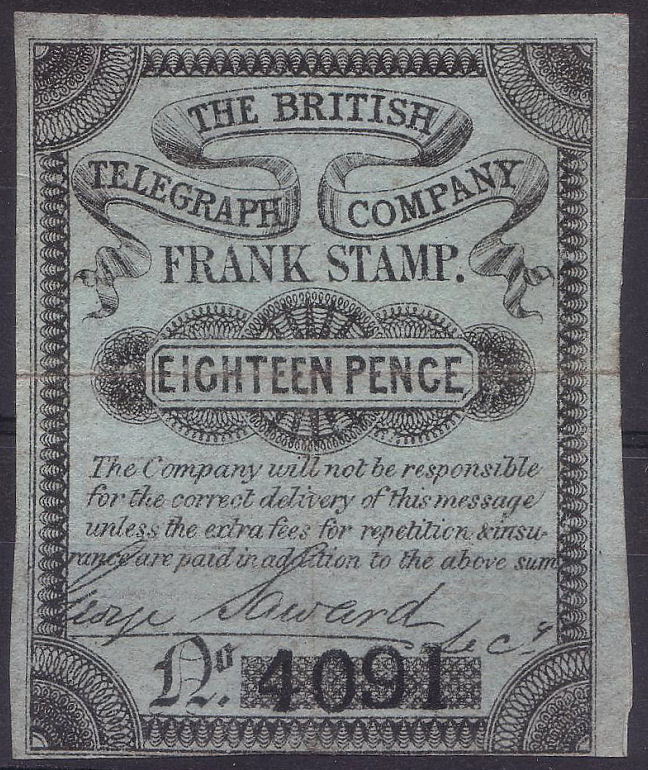 |
| 18d (1s6d) - Unknown by Hiscocks and L&H - Courtesy of Steve Lawrie. (Column-3) |
This Eighteen Pence stamp is not listed by Hiscocks, Langmead and Huggins say it is unknown, but point out that the surplus stock of paper.
from this company, that was later used for the British & Irish Magnetic Telegraph Company, included 4 different colours and predicted the
existence of 1s6d and 3s stamps that used those papers. If true, that implies that the 3s would be on dull buff paper.
The 2/6d stamp of the British & Irish Magnetic Telegraph Co was on that paper.
Langmead and Huggins also give a table of the rates used as of 1 August 1855:
| Range | Price |
|---|---|
| Within 50 miles | 1s 6d |
| Within 100 miles | 2s |
| Within 150 miles | 3s |
| Beyond 150 miles | 4s |
| To Belfast & Dublin | 5s |
| Additional words | 3d |
I guess paying the 3s or 5s rates would be easier with a 3s stamp, but doable, more problematic is that the tariffs from London
on the back of an 1854 form shown below show 3 places having a rate of 1s, as well as a requirement for 3d for additional words!
A 3d denomination would be more useful than a 3s value. Either way, none appear to have survived.
One final thought, there would be a need to pay for an odd 3d, 6d, 9d, 1s or 1s3d. That would need up to 5 x 3d stamps.
Perhaps the 18d were routinely bisected to make 9d towards that. It would explain the shortage of existing 18d stamps,
as well as the enigmatic crease across the existing one. Just a thought that will probably remain pure conjecture.
If the 2s was also bisected, all those values could be covered with a maximum of 2 stamps.
Hiscocks lists the following, Rarity-guide taken from L&H:
| RH # | Hisc. | Description | Qty known | Highest control | Mint | Used |
|---|---|---|---|---|---|---|
| RH1 | 1s6d black on green | 1 | 4091 | 3500.00 ? | - | |
| RH2 | H1 | 2s black on blue | 7 | 3254 | 1700.00 | - |
| RH3 | 3d / 3s black on dull buff ? | 0 | - | - | - | |
| RH4 | H2 | 4s black on yellow | 9 | 8802 | 1700.00 | - |
Look here for an explanation of the table.
| 2s - RH1 - 3243/3244 re-united pair, Courtesy of Mark Gibson. 3243 has the letter 'T' and part of 'H' of the watermark A mark can be seen above 'EG' of 'TELEGRAPH' on both left stamps and above 'RA' of 'TELEGRAPH' on both right stamps. |
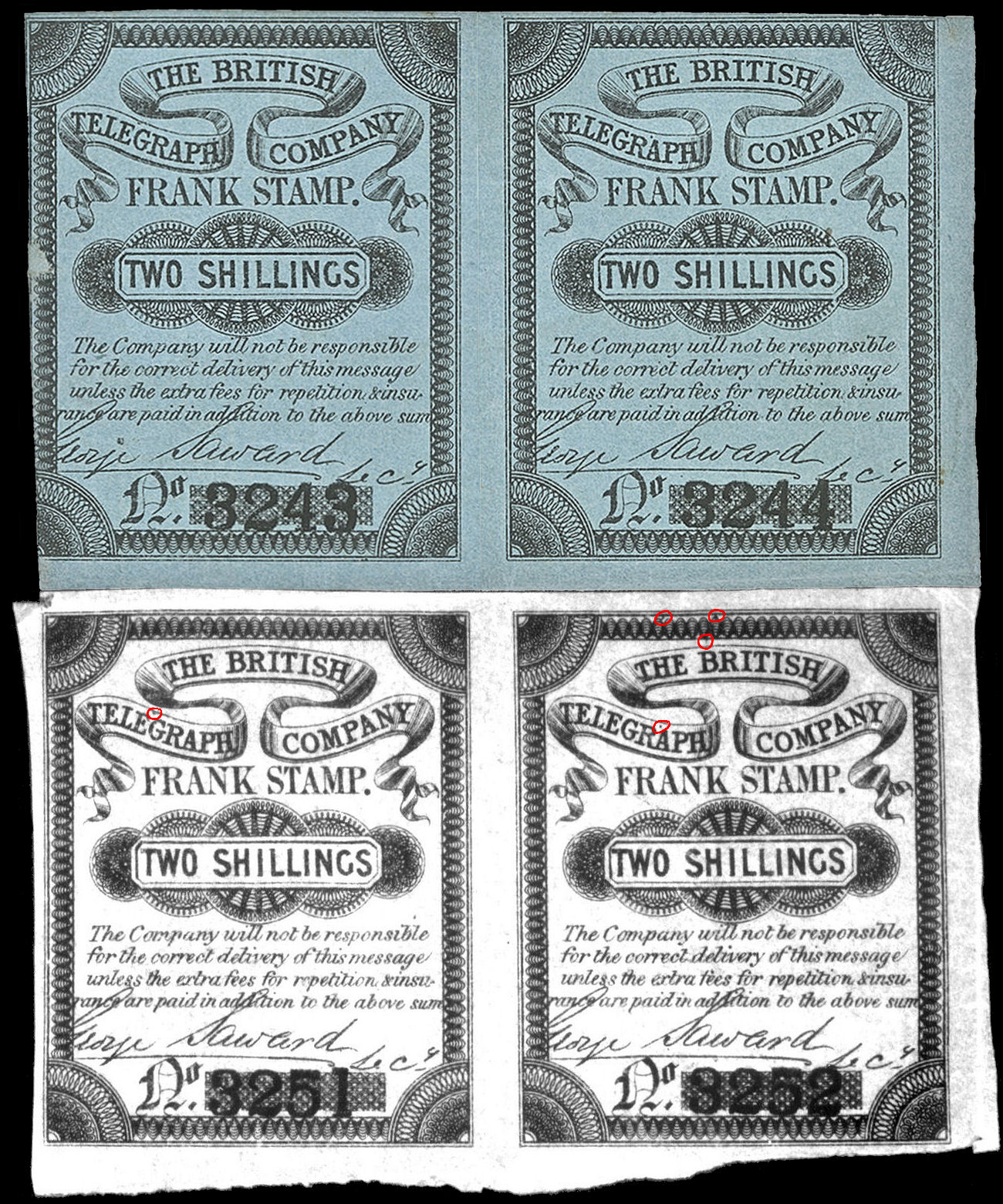 |
| 3251/3252 pair, illustrated in Langmead & Huggins' book (Fig.23), courtesy of the
Great Britain Philatelic Society. (If any reader has this pair now, it should have some very good watermark parts on both stamps.) |
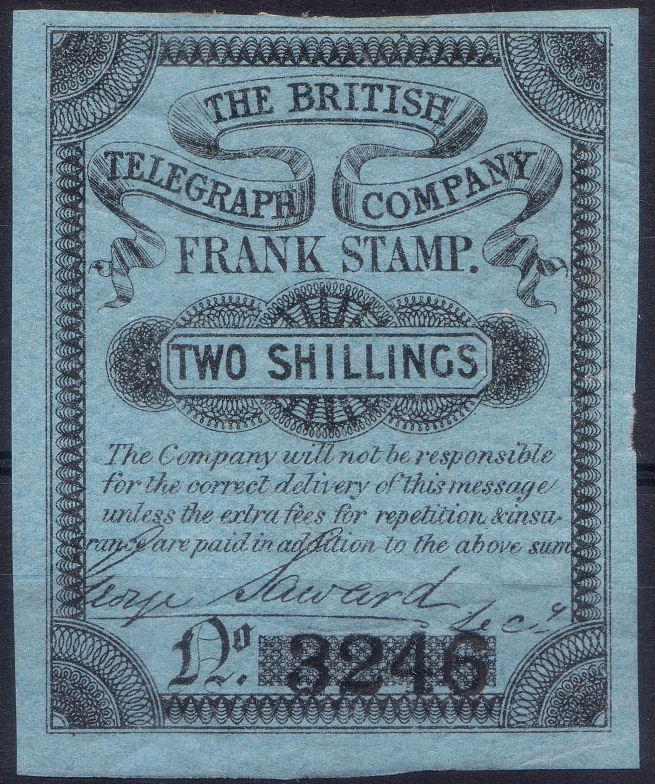 |
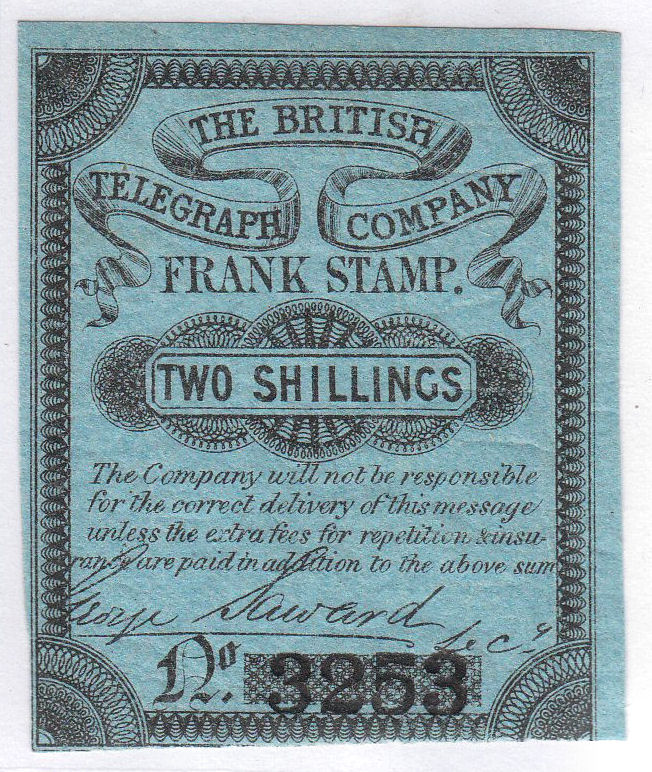 |
| 3246 Courtesy of Steve Lawrie. (column-6) | 3253 Courtesy of Martien Blank. (column-5) |
| 2s RH1 | |
| 4s - RH2 - 8791/8792 re-united pair, illustrated in Langmead & Huggins' book (Fig.24), courtesy of the Great Britain Philatelic Society. |
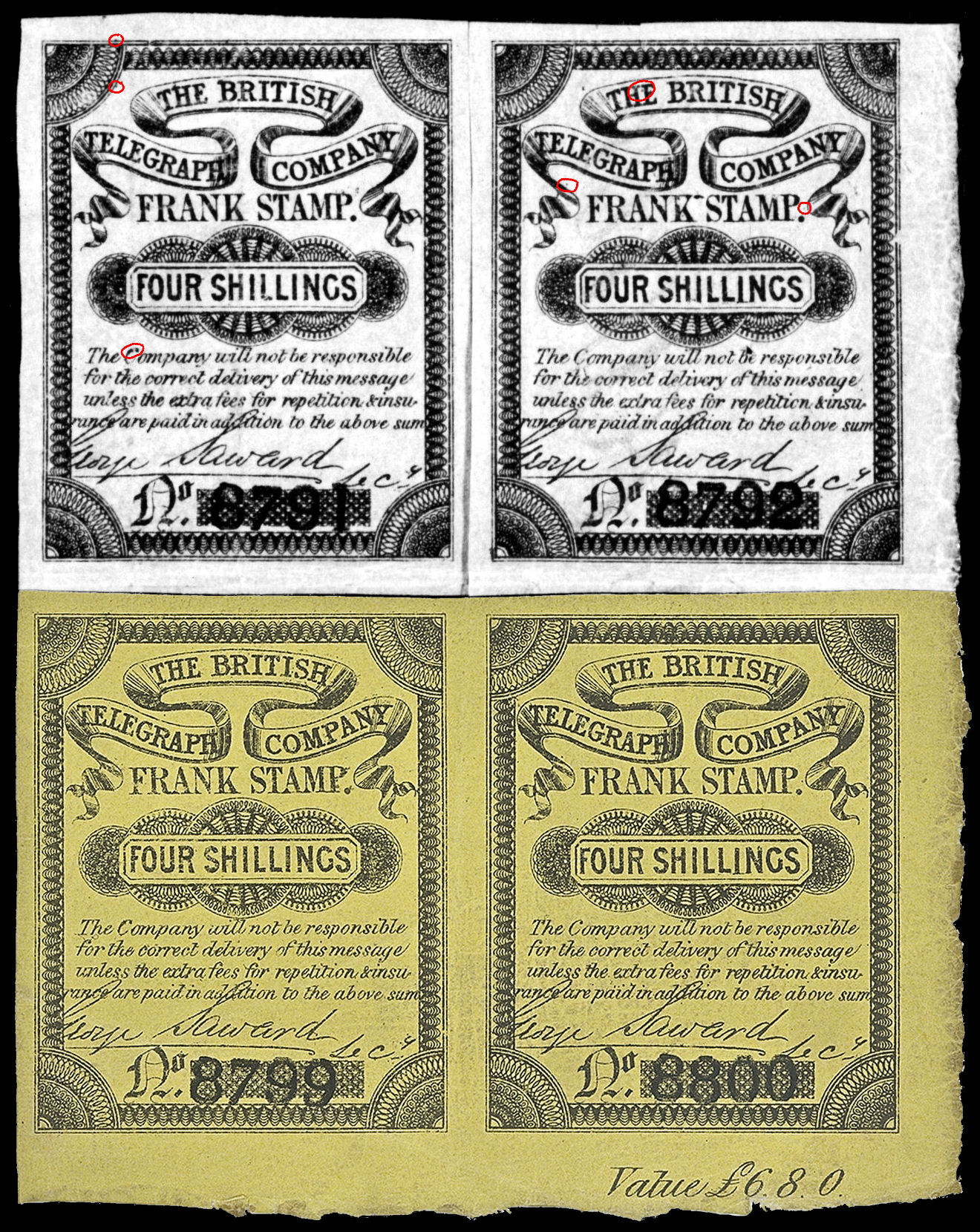 |
| 8799/8800 pair, showing sheet value inscription in bottom corner, courtesy of Mark Gibson. The £6.8.0 is the price of 32 stamps of 4s each, indicating 4 rows of 8 stamps per row. |
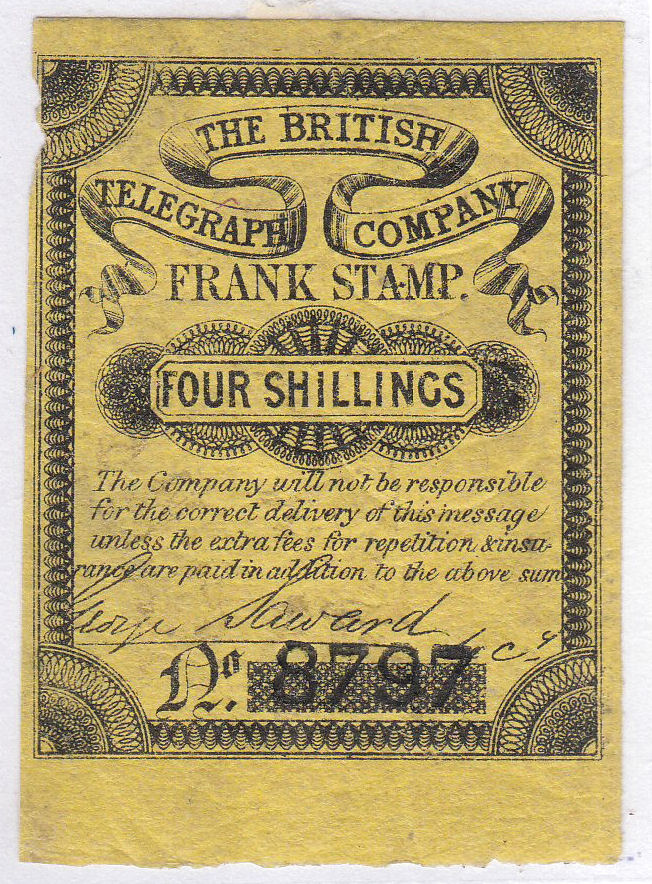 |
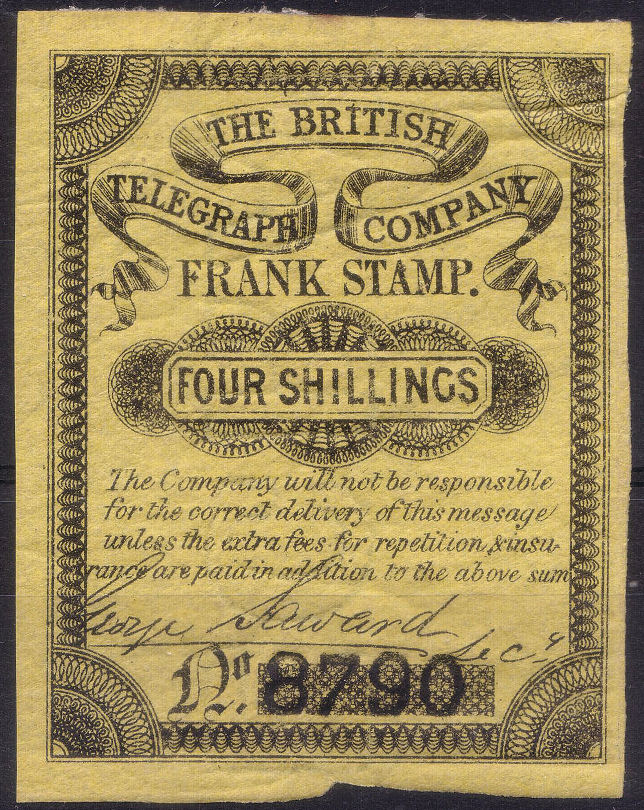 . . . |
| 8797 Showing bottom edge of the sheet, courtesy of Martien Blank. (column-5) | 8790 Courtesy of Steve Lawrie. (column-6) |
| 4s RH2 Distinctive flaws shown on a pair of the next sheet shown below. | |
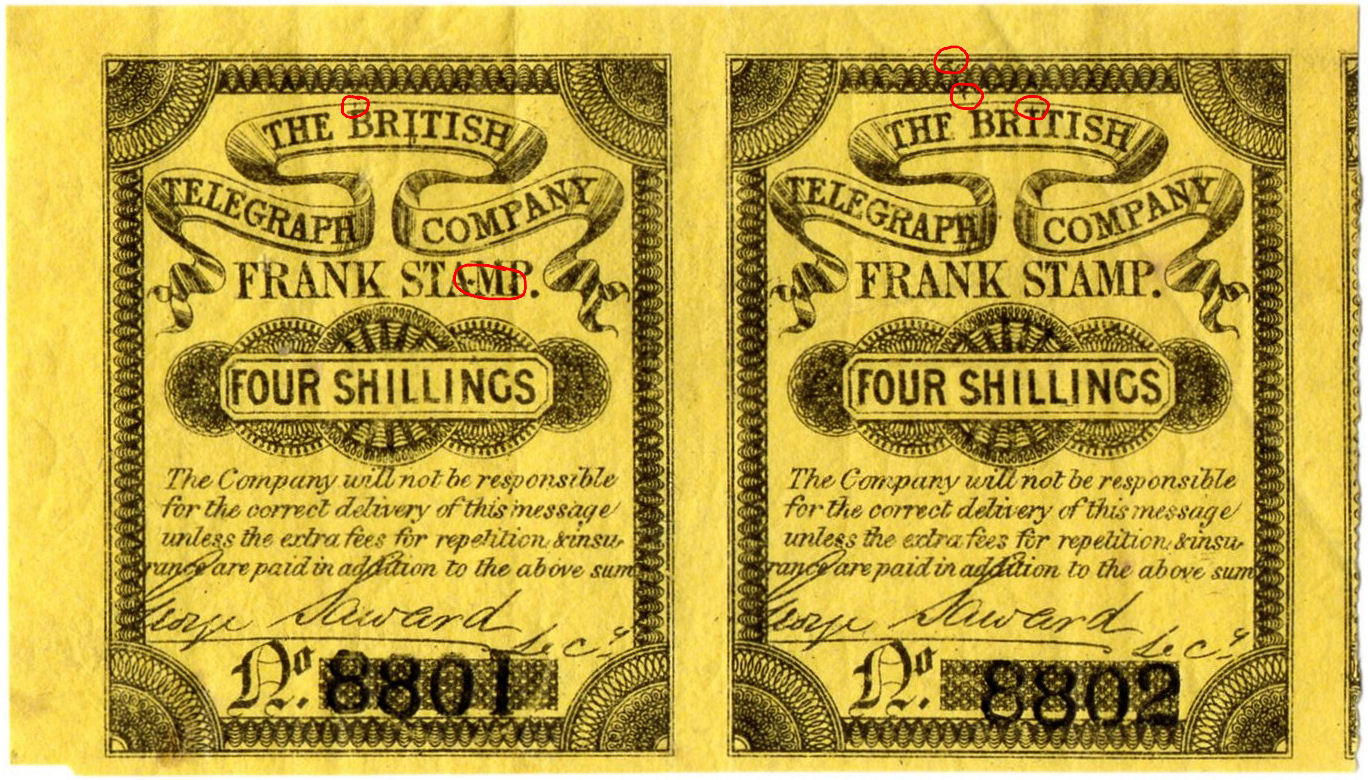 |
|
| 8801 (Column-1) with mark between 'AM' of 'STAMP' indicated. This is also on 8797 (Column-5) | 8802 (Column-2) with Marks around top frame and 'BRITISH'. This is also on 8790 (Column-6) |
| A 4s pair from the following sheet - Courtesy of Les Bottomley. These flaws are not on the pair illustrated by L&H (8791/2), but are on 8797 and 8790 respectively. | |
This shows that column 1 and 2 match columns 5 and 6 respectively. Langmead & Huggins (page 19) illustrate the pair 8791/2 representing columns 7 and 8.
These do not match the others or each other. The scans are not wonderful, but good enough to show a clear mark between 'K S' of 'MARK STAMP' on 8792.
I strongly suspect that columns 7 and 8 will match columns 3 and 4 respectively, giving a transfer block of 4 stamps, and so 4 different stamps on the sheet.
I do not have enough scans of the 2 shilling to prove it did not have a transfer block of 8, but what I have is consistent with a transfer block of 4 also.
This company merged with the English & Irish Magnetic Telegraph Company in 1857 to form The British & Irish Magnetic Telegraph Company,
which used the remainder of these paper stocks.
According to Walter Morley in "The Fiscal Philatelist" March 1893, these sheets used for printing 12 rows of 5 British & Irish stamps,
measured "3½in. x 18 ½in. (outer edge to outer edge of stamps). Since the stamps were over an inch wide, 5 stamps will not fit in 3½in, so he must have meant 5½in.
My best estimate for the BTC sheets is 11½in x 17½in
Judging by the colours of the first British & Irish stamps, if the 3s exists it is probably on dull buff paper, the colour of the British & Irish 2/6d stamp.
Until recently, the only British & Irish stamps I have seen on paper that might be described as dull buff were 2s yellow colour changelings.
However it has emerged that the 2/6d is actually on BTC paper and not Thunderbolts as described by other authors including Langmead & Huggins.
L & H also state (page 23) that a block of 30 of the 5/- blue British & Irish is known showing the complete watermark.
Unfortunately they chose not to illustrate it or state the whereabouts of the block.
Here is a reconstruction of the watermark at 3 / 8 scale on a half sheet of 4s. Note that the stamps are sideways.
Walter Morley in "The Fiscal Philatelist" March 1893 described this watermark as seen on the 2s and 5s of the British & Irish Magnetic Telegraph Company.
I am using this description together with scans of the backs of stamps that I have scans of.
Morley said there were two complete copies of the watermark to each sheet with 2½ inches between them, but he was going by the narrow BIM stamps.
The watermark on the 8801/2 pair can only be explained by an original sheet having 2x2 copies of the watermark. that was then cut down for the use of the stamps.
3/8th size images
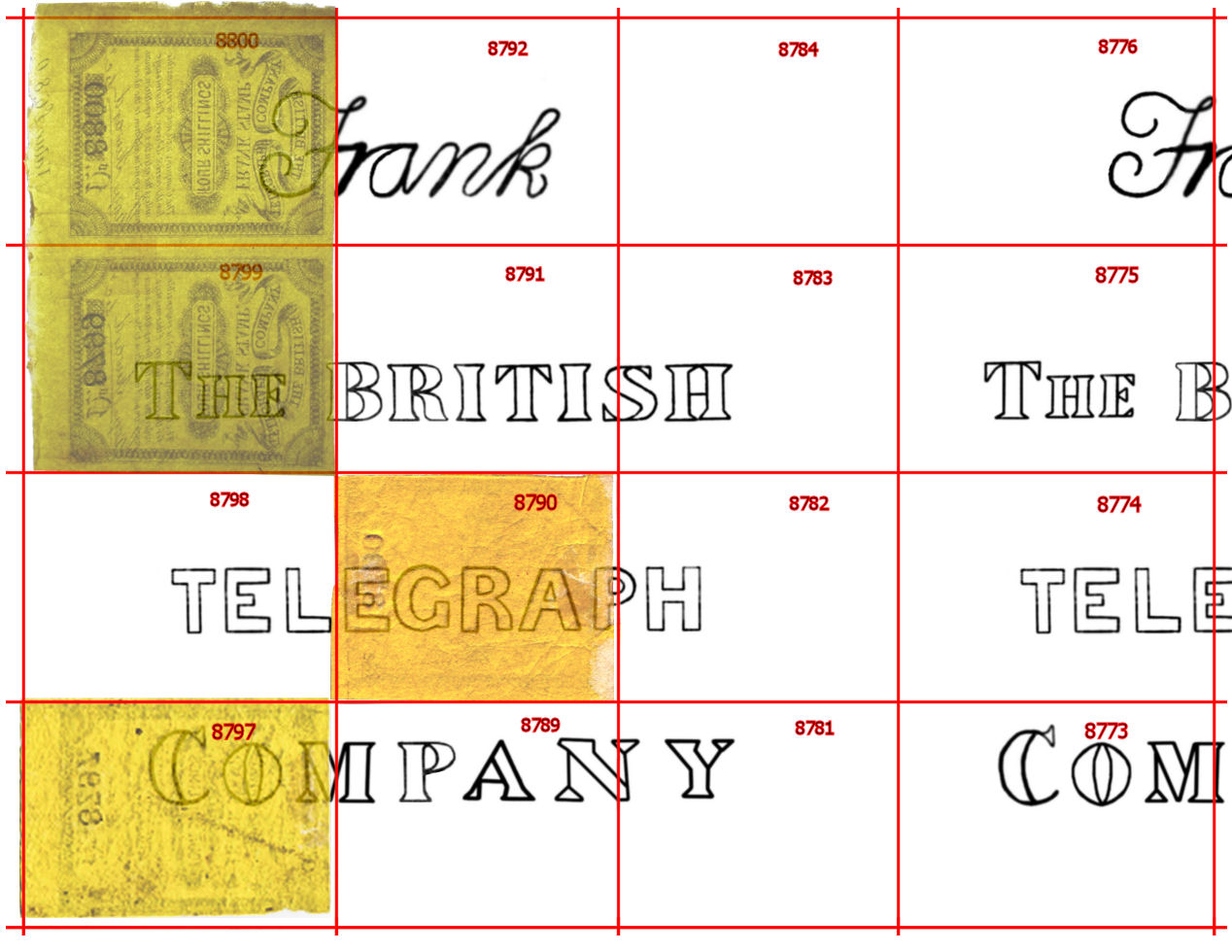
I 'mirrored' the 2s image and the 18d image (courtesy Steve Lawrie) on the reconstruction below, I did not need to mirror the 4s images above.
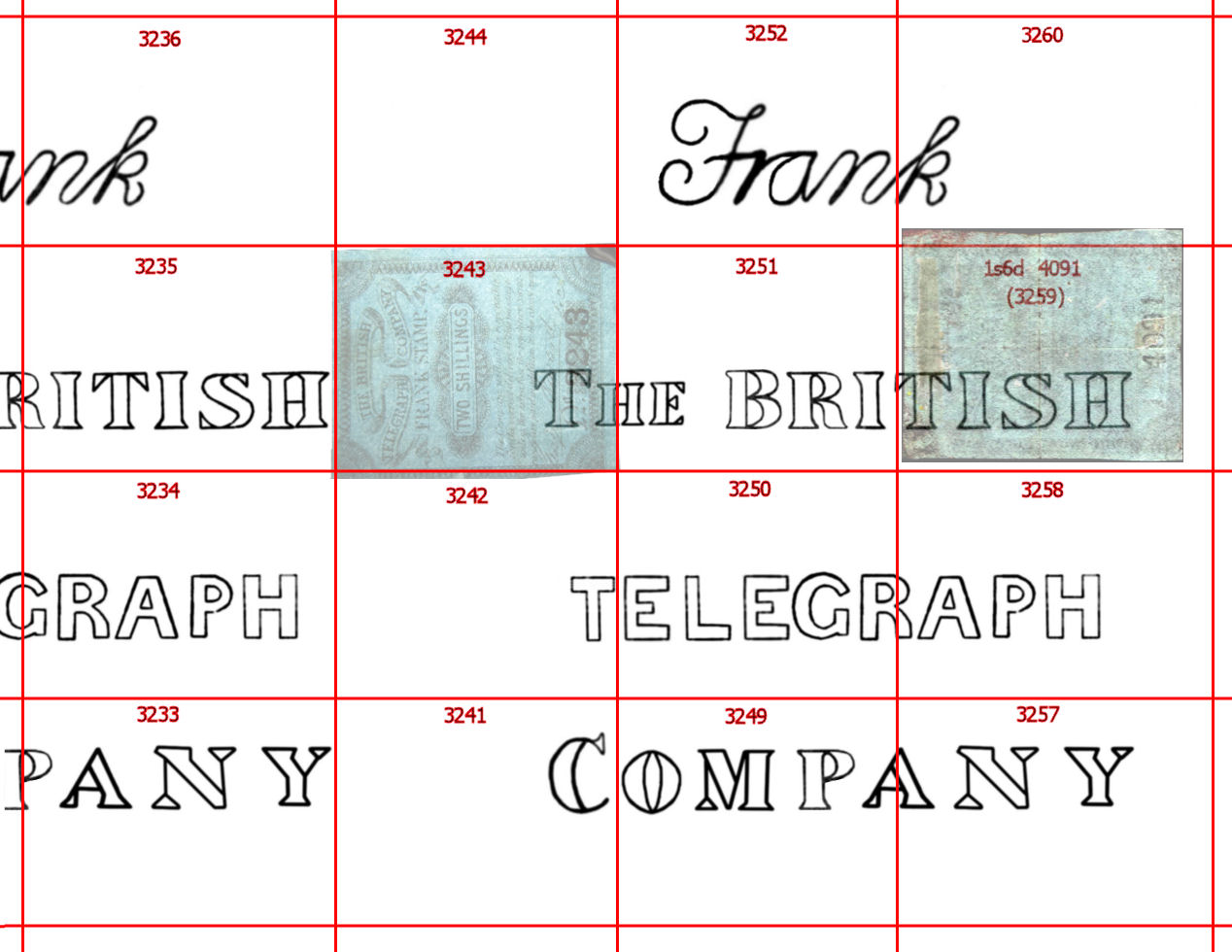
The paper used for the stamps was clearly originally intended for something different.
The word 'Frank' in this watermark suggests one possibility.
The Electric Telegraph Company created Franked Message paper on different coloured papers.
It is thought that these were initially used in 1851 for the London Exhibition in Hyde Park.
It may well be that this watermark was originally created for a paper mould intended to produce sheets for 4 such Franked Message papers each.
Then later , following the lead of the ETC, the idea was abandoned and Frank Stamps were produced instead.
Rather than waste the manufactured sheets, they were cut down to accommodate the Frank Stamps.
Ultimately the remaining paper was pressed into service for stamps of the British & Irish Magnetic Telegraph Company.
A further reduced image to show the supposed original sheets and the part used for the 32 stamps in yellow,
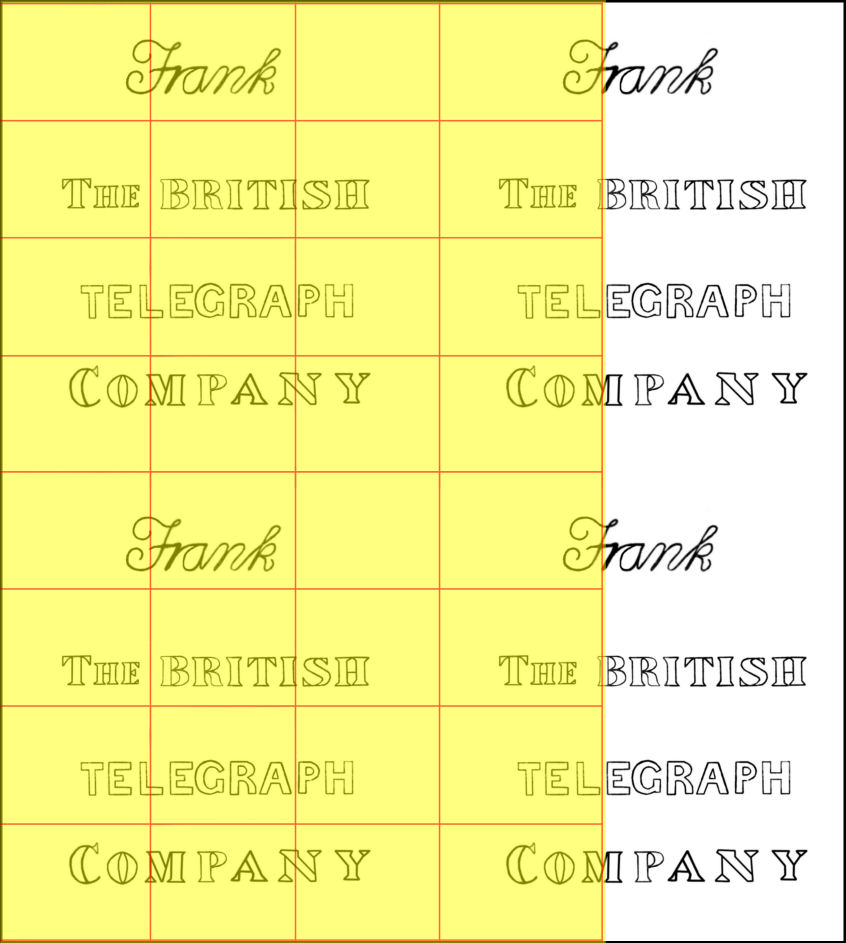
The Eighteen Pence stamp numbered 4091 should be the third stamp on the bottom row.
| 4065 | 4066 | 4067 | 4068 | 4069 | 4070 | 4071 | 4072 |
| 4073 | 4074 | 4075 | 4076 | 4077 | 4078 | 4079 | 4080 |
| 4081 | 4082 | 4083 | 4084 | 4085 | 4086 | 4087 | 4088 |
| 4089 | 4090 | 4091 | 4092 | 4093 | 4094 | 4095 | 4096 |
L&H provide a table of 6 known Two Shilling stamps. I have reproduced it here in green and added the one above in mauve.
L&H rightly point out that if these are also in 4 rows of 8 stamps, then this is from the middle of a sheet.
The control numbers in red are ones reported by Raymond Lister to be in the Royal Collection. I do not have scans of them.
| 3233 | 3234 | 3235 | 3236 | 3237 | 3238 | 3239 | 3240 |
| 3241 | 3242 | 3243 | 3244 | 3245 | 3246 | 3247 | 3248 |
| 3249 | 3250 | 3251 | 3252 | 3253 | 3254 | 3255 | 3256 |
| 3257 | 3258 | 3259 | 3260 | 3261 | 3262 | 3263 | 3264 |
L&H also provide a tables of 6 known Four Shilling stamps.
I have reproduced it here in green and added the one above in mauve, showing unknown stamps in stamp-colour.
The darker greens represent horizontal pairs, this is by combining L&H information with that from Raymond Lister.
| 8769 | 8770 | 8771 | 8772 | 8773 | 8774 | 8775 | 8776 |
| 8777 | 8778 | 8779 | 8780 | 8781 | 8782 | 8783 | 8784 |
| 8785 | 8786 | 8787 | 8788 | 8789 | 8790 | 8791 | 8792 |
| 8793 | 8794 | 8795 | 8796 | 8797 | 8798 | 8799 | 8800 |
In the bottom-right margin below 8800 is the inscription 'Value £6. 8. 0.' which implies 32 x 4/- stamps in 4 rows of 8.
I have recently been sent a photograph of another pair, 8801 and 8802 which are from the next sheet.
| 8801 | 8802 | 8803 | 8804 | 8805 | 8806 | 8807 | 8808 |
| 8809 | 8810 | 8811 | 8812 | 8813 | 8814 | 8815 | 8816 |
| 8817 | 8818 | 8819 | 8820 | 8821 | 8822 | 8823 | 8824 |
| 8825 | 8826 | 8827 | 8828 | 8829 | 8830 | 8831 | 8832 |
These were bought in Charing Cross Market (London), probably in the late 1960's.
There is the extra piece of information "8801 has an extra dot between the letters A & M of STAMP above the four shillings."
This matches the image of 8797, now shown above. It is not on 8791 or 8792 in the L&H book, though 8792 has a different distinct feature.
It looks like each row is a copy of the first row, and the right 4 columns are the same as the left 4 columns.
Watermark orientation on known BTC examples (as viewed from front).
| Denom. | Sheet No. | Control range | Orientation |
|---|---|---|---|
| 18d. | 128 | 4065-4096 | Sideways-inverted |
| 2s. | 102 | 3233-3264 | Sideways-inverted |
| 4s. | 275 | 8769-8800 | Sideways-inverted & reversed |
| 4s. | 276 | 8801-8832 | Sideways-inverted & reversed |
In 1857 this company merged with 'The English and Irish Magnetic Telegraph Company'.
Received Message form of the British Electric Telegraph Company dated 1/11/53. Size 108 x 139 mm. - My Ref. BETC-185-1
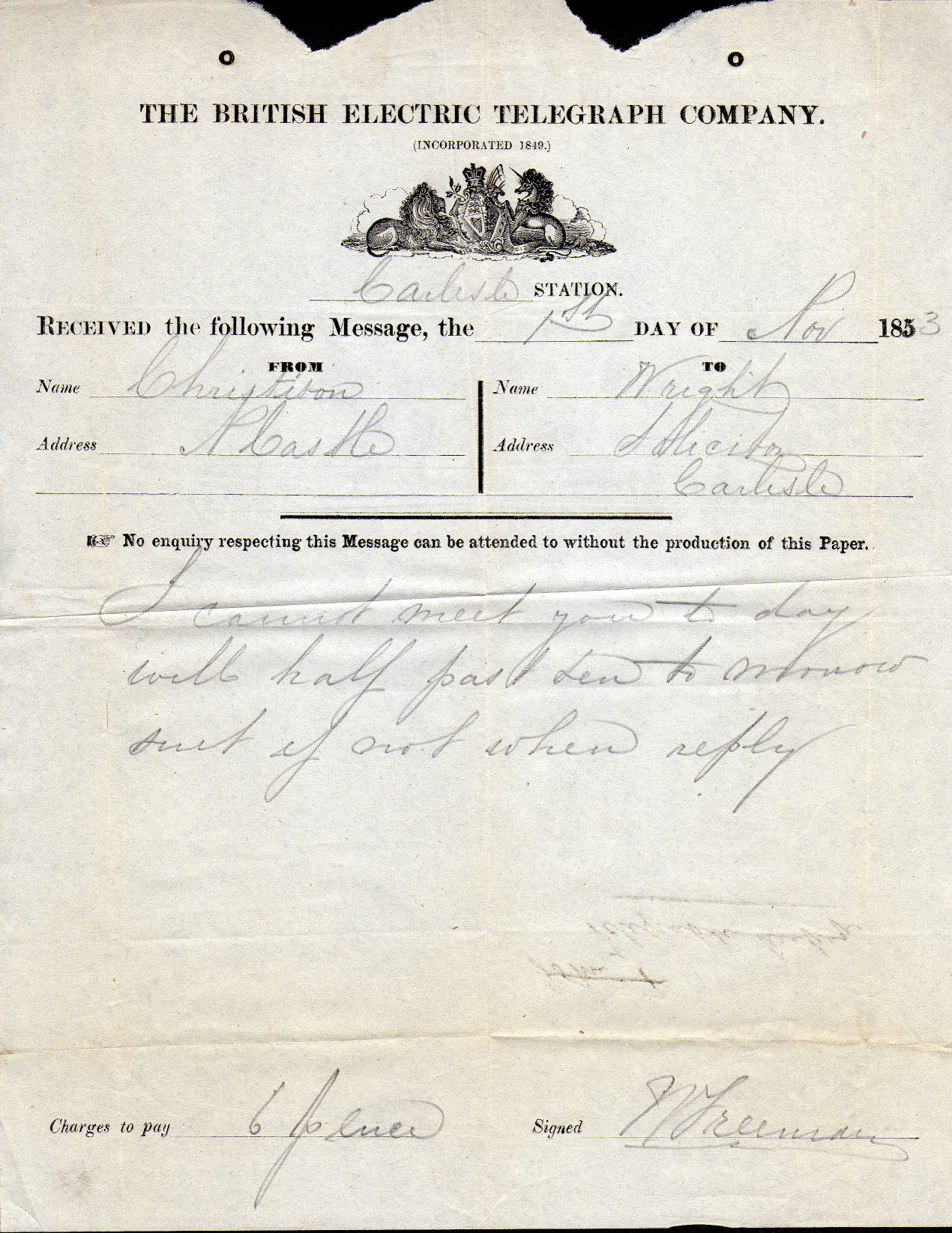
This is presumably old stock as the word "Electric" was dropped from the Company Name on June 13, 1853 in a Royal Charter.
Image courtesy of Andrew Higson.
Now headed "The British Telegraph Company." size 152 x 193 mm. - My Ref. BTC-185-1
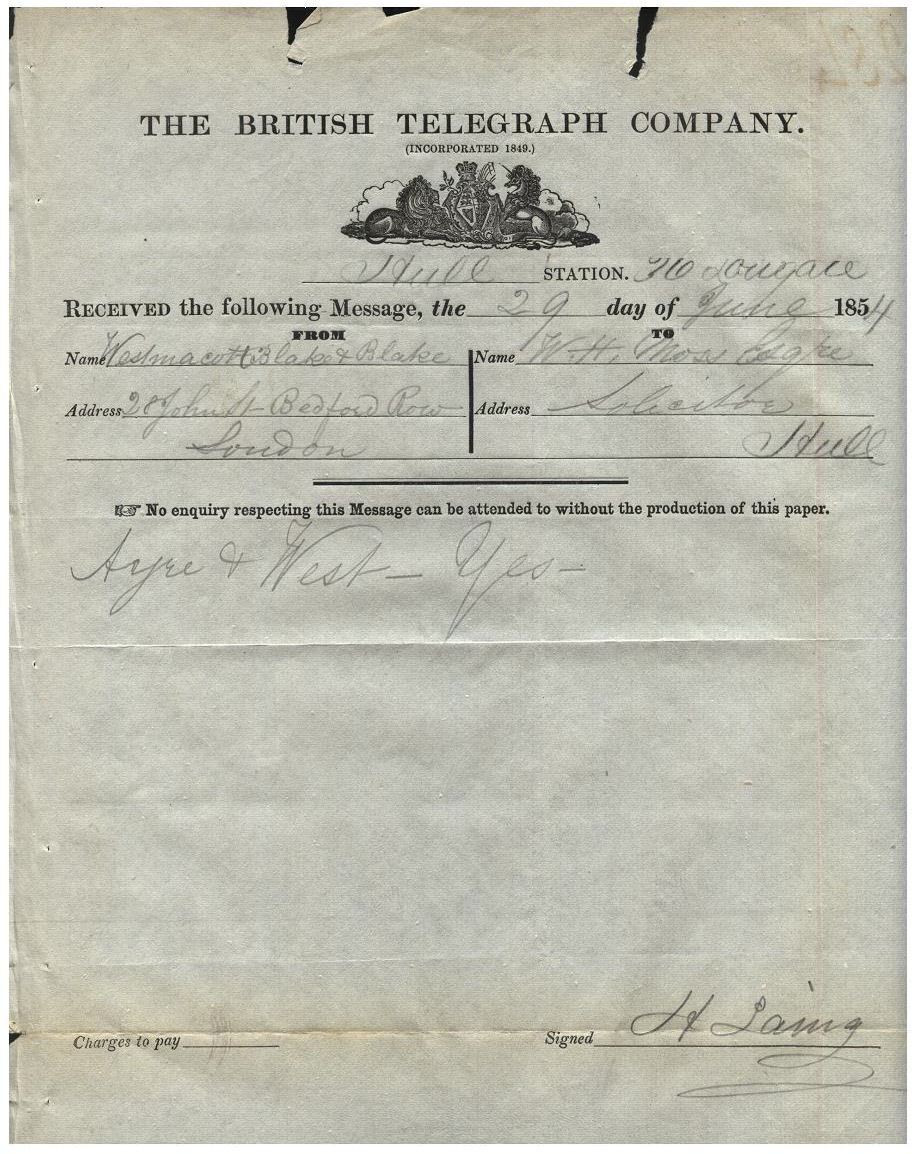
British Telegraph Company 29th. June 1854 stationery courtesy of Barry Clark.
A different style to the above, including reference to 'European Telegraph Company', an International Received Message form of 11 September 1854. Size 216 x 285 mm. - My Ref. BTC-2-4/9/54
courtesy of Edward Coombes
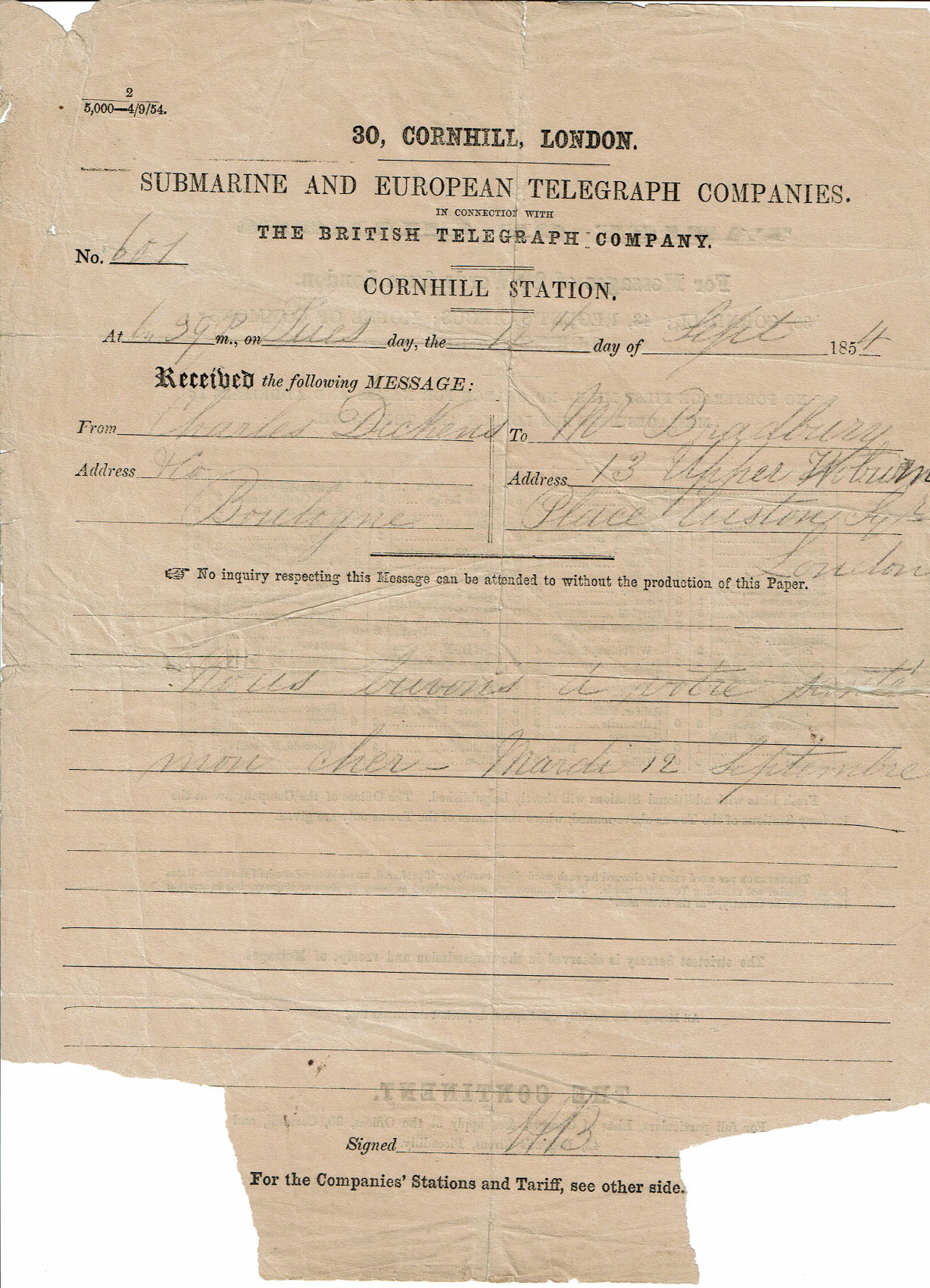
The top-left suggests that this is one of only 5,000 printed 4/9/1854 (only 7 days before use). This was from Charles Dickens in Boulogne to Mr. Bradbury, London.
Edward tells me that " Bradbury was a partner in Bradbury & Evans who printed Dickens books. Dickens, I believe, spent part of his summers in France."
The back gives a tariff of charges for 20 words from London, and says for the continent
"For full particulars, Lists of charges, &c., apply at the Offices, 30, Cornhill, and 43, Regent's Circus, Piccadilly."
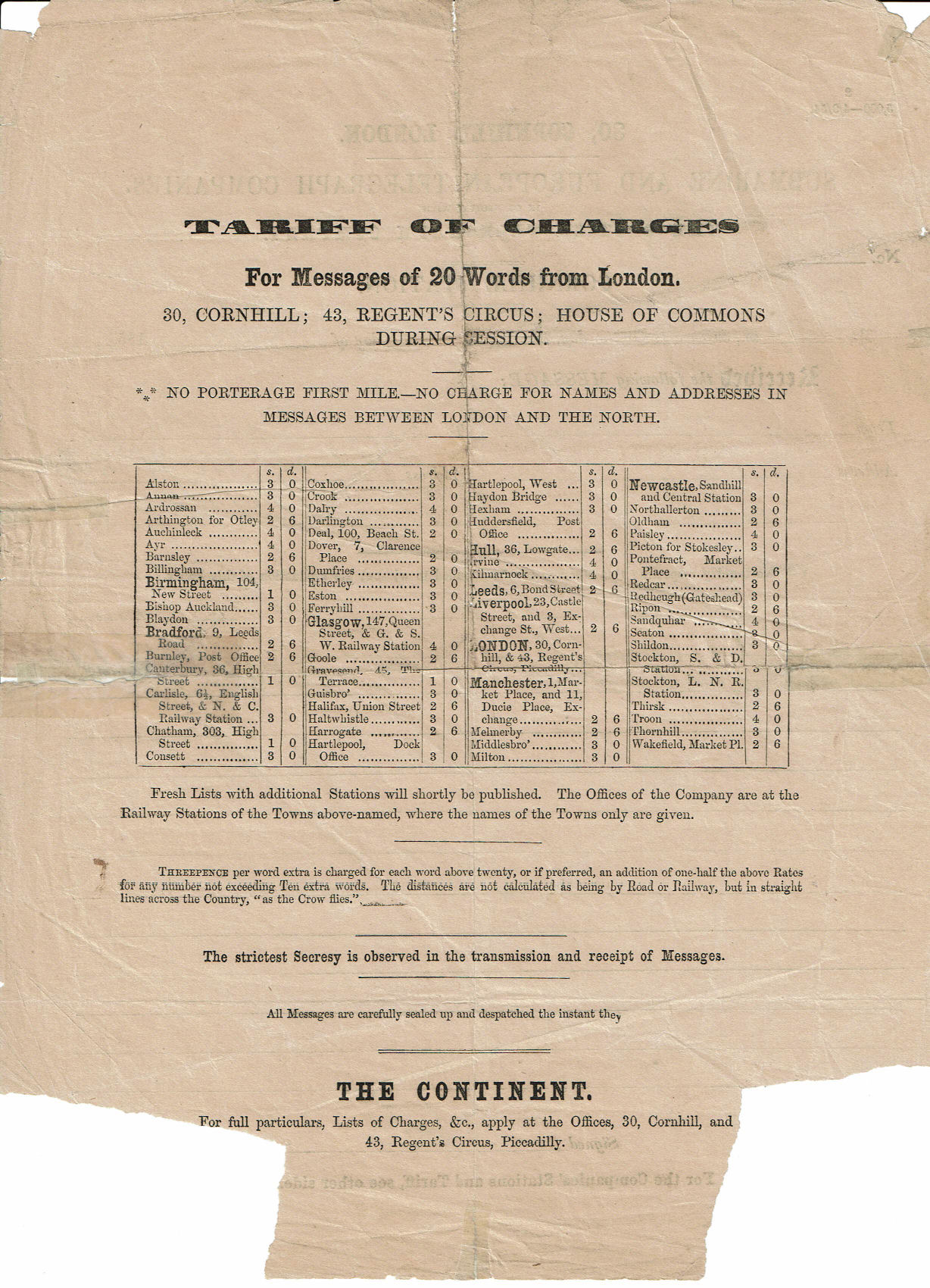
International charges could be affected by changes of rates in the countries at both ends, as well as possible intervening countries and cable operators.
They could thus change fairly frequently and at short notice. A list of 72 stations on the back, including London.
By 1856, this company was operating in conjunction with the Submarine Telegraph Company
Langmead & Huggins list this and a number of other forms signed on the back by George Saward, under the Submarine Telegraph Company but they are of the style above.
George Saward was instrumental in the formation of the Atlantic Telegraph Company and the laying of the transatlantic cable.
British Telegraph and Submarine Telegraph Companies 27th. March 1856 front and back - courtesy of Steve Lawrie. Size 160 x 187 mm. - My Ref. BTC_W{15/8/55}
The form number on this is W{15/8/55}200000 which I take to mean that 200,000 were printed on 15 August 1855.
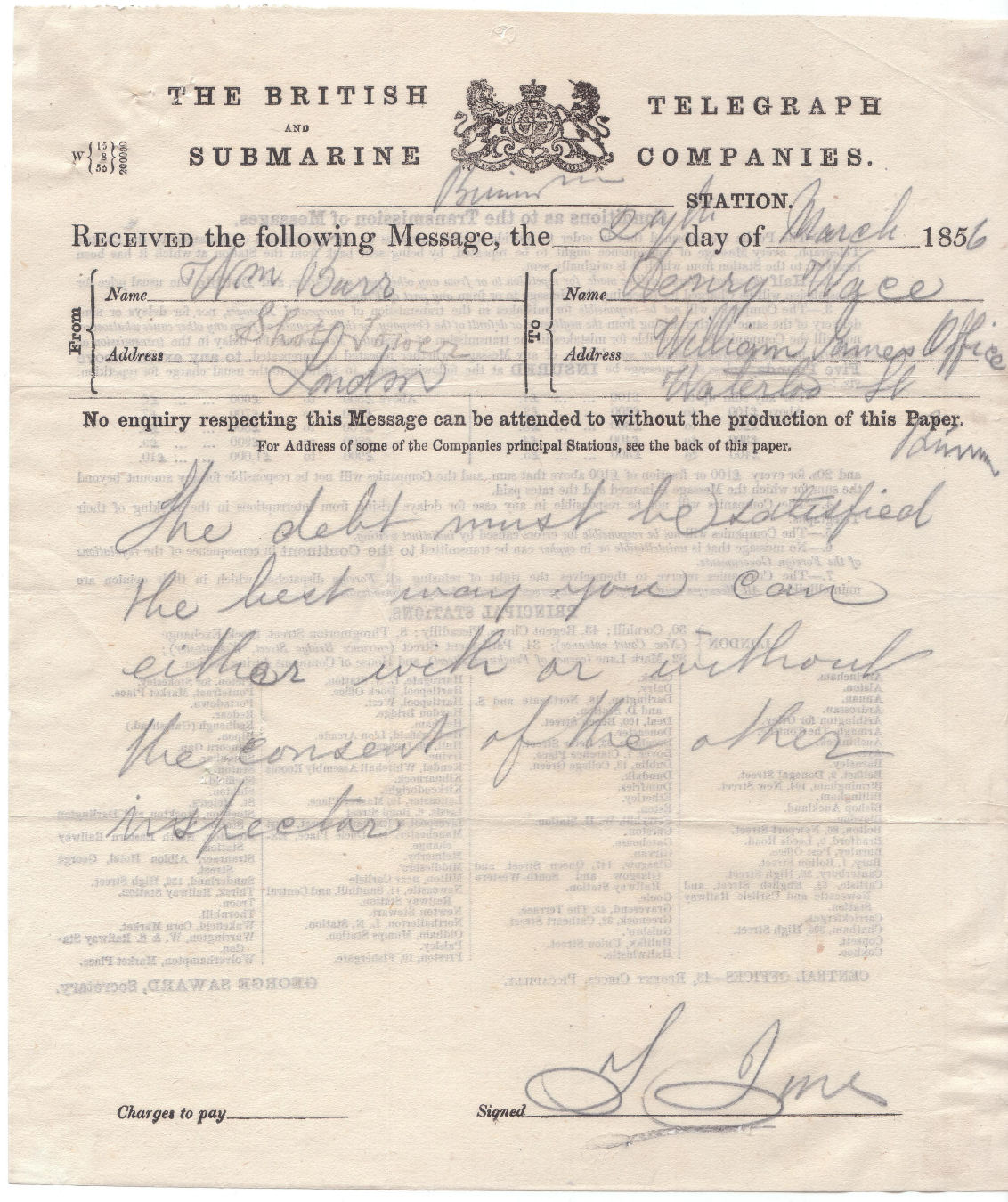
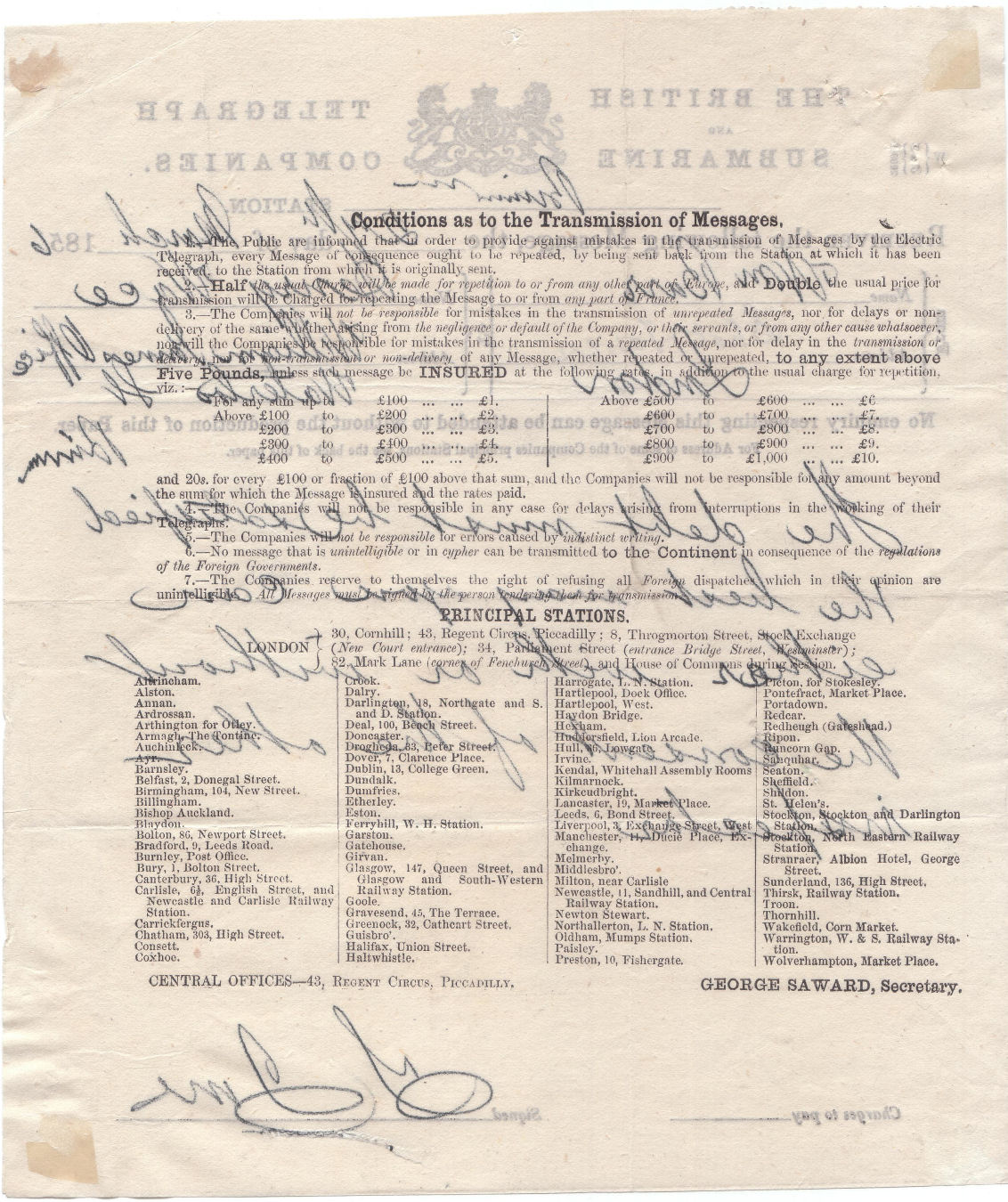
The back lists the Central Office and 6 Branch offices in London, together with 93 cities/towns having one or more stations.
British and Submarine Telegraph Companies 18th. November 1856 front and back - courtesy of Steve Lawrie. Size 191 x 227 mm. - My Ref. BTC_W{26/4/56}
The form number on this is W{26/4/56}100000 which I take to mean that 100,000 were printed on 26 April 1856.
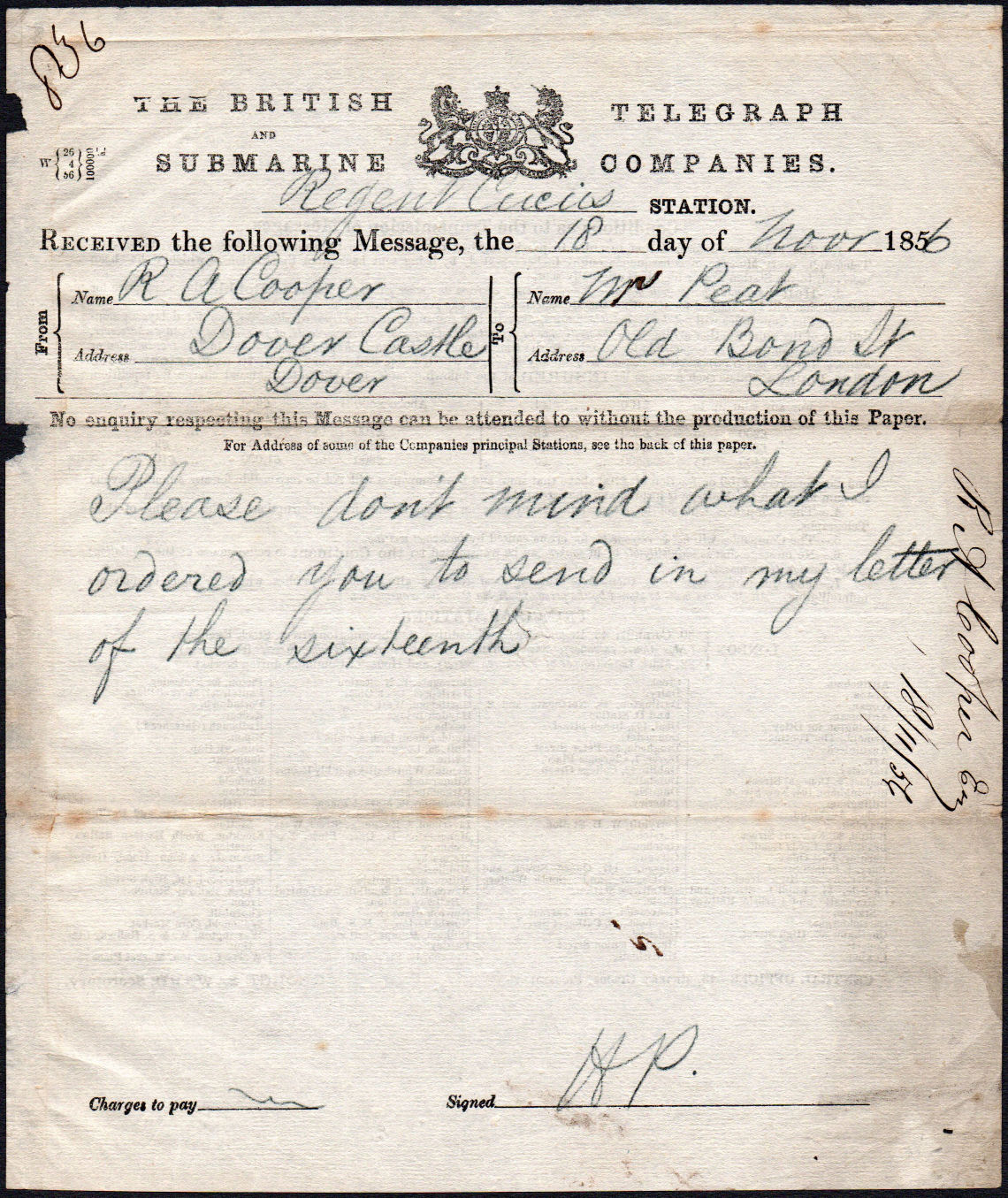
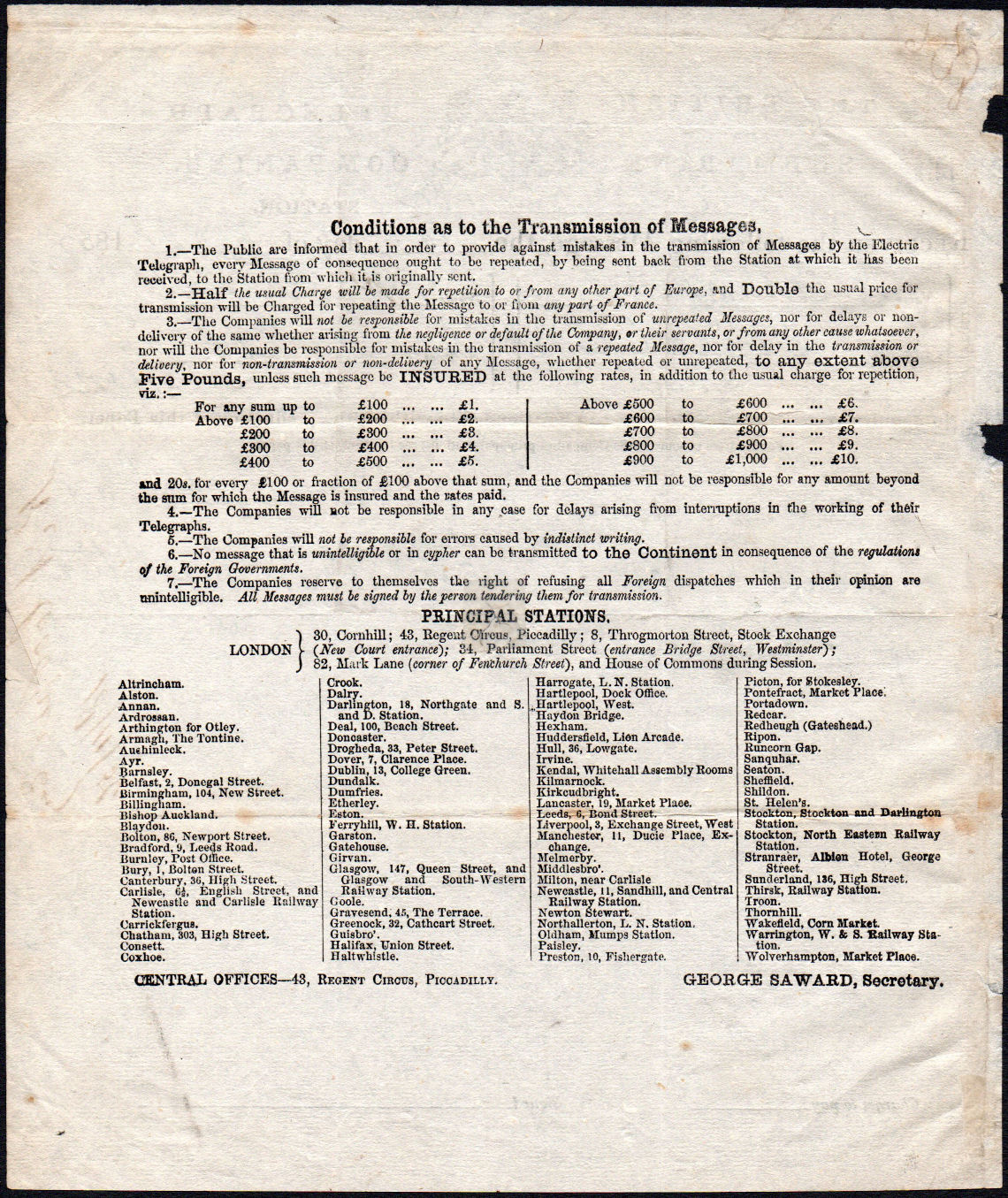
The back lists the Central Office and 6 Branch offices in London, together with 93 cities/towns having one or more stations.
As far as I can see, apart from the form number, this is the same as the last, suggesting about 200,000 forms used in 8 months.
In a similar style to the above (note the form numbers at front top-left), a receipt of 25 September 1856 courtesy of Edward Coombes. - My Ref. BTC_W3{3/8/55}
Form number W / 3 {3/8/55} 60000 suggesting 60,000 printed 3 August 1855. Size 190 x 110 mm.
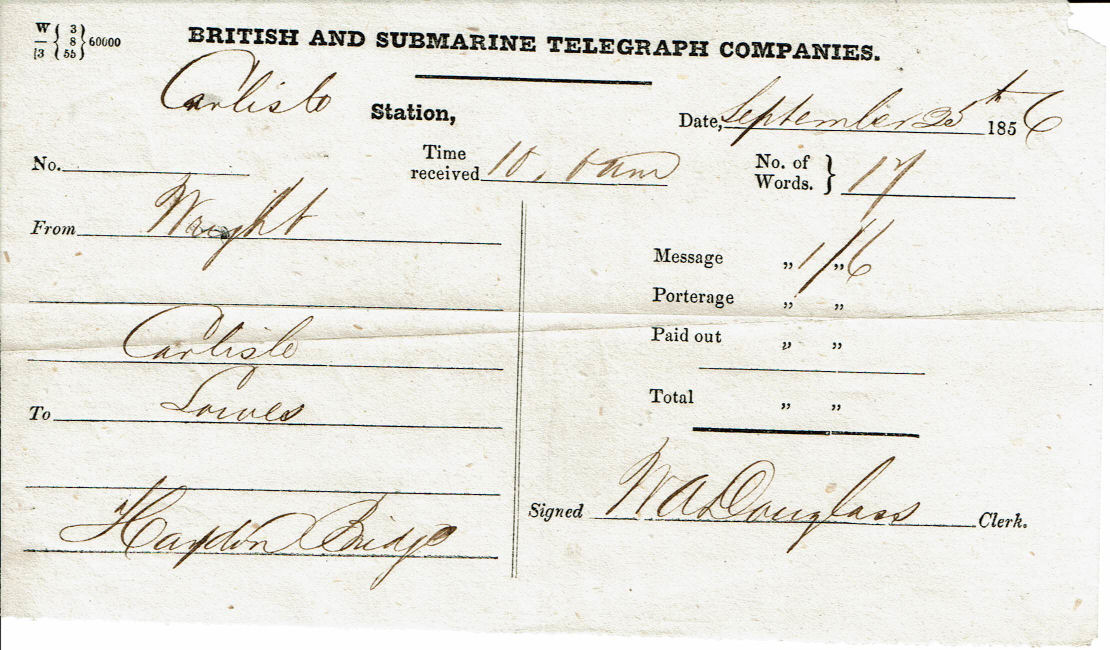
See also forms listed under the Submarine Telegraph Company.
| Provisional Reference | L & H # | Date on form | Date used | size mm. | London | Country | Comments | Illustrated |
|---|---|---|---|---|---|---|---|---|
| BETC-185-1 | - | 185_ | 1/11/53 | 108 x 139 | - | - | Headed "British Electric Telegraph Company" | Yes |
| BTC-185-1 | - | 185_ | 29/6/1854 | 152 x 193 | - | - | Headed "British Telegraph Company" | Yes |
| BTC-2-4/9/54 | - | 4/9/54 | 11/9/1854 | 216 x 285 | - | - | With Submarine and European Telegraph Companies. | Yes |
| BTC_W{15/8/55} | - | 15/8/55 | 27/3/1856 | 160 x 187 | - | - | With STC. 6 London & 93 country stations on back. | Yes |
| BTC_W{26/4/56} | - | 26/4/56 | 18/11/56 | 152 x 193 | - | - | Same as last | Yes |
| BTC_W3{3/8/55} | - | 3/8/55 | 25/9/56 | 190 x 110 | - | - | Receipt | Yes |
British and Telegraph Company Envelope front and back - courtesy of Steve Lawrie. - My Ref. BTC_Env-1856-1
This envelope goes with the form shown above of 27 March 1856.
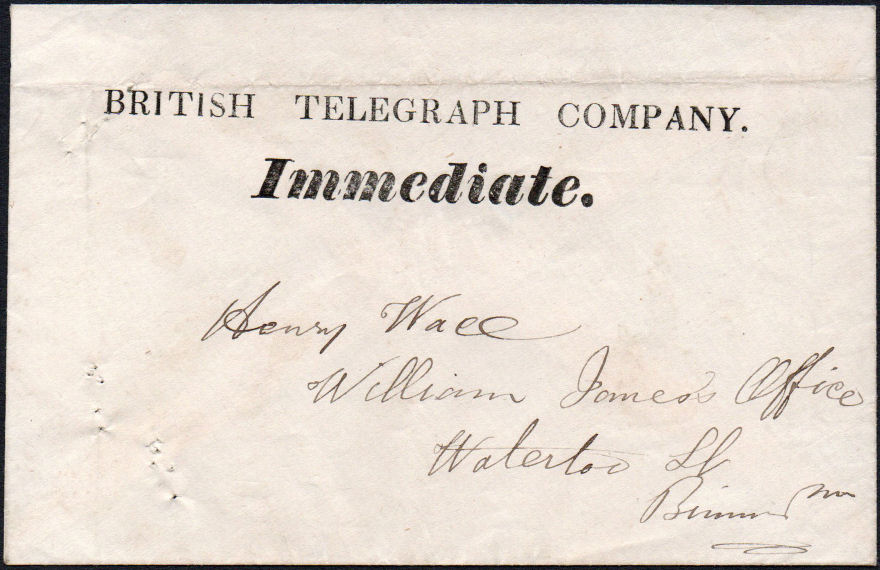
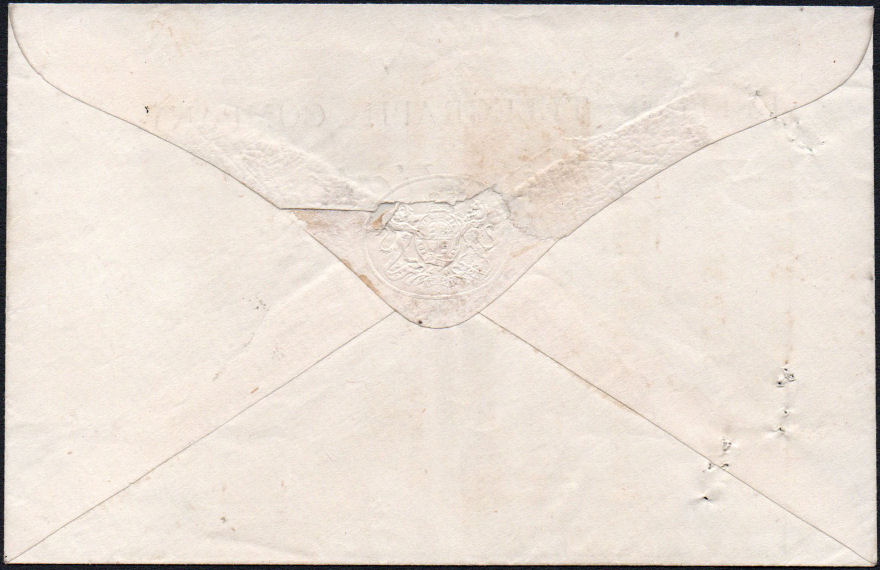
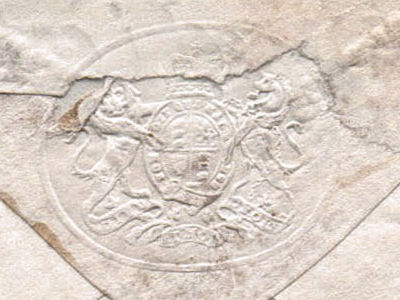
British and Submarine Telegraph Companies Envelope front and back - courtesy of Steve Lawrie. - My Ref. BTC_Env-1857-1
This envelope has pencilled on the back 1857. It is smaller than the last.
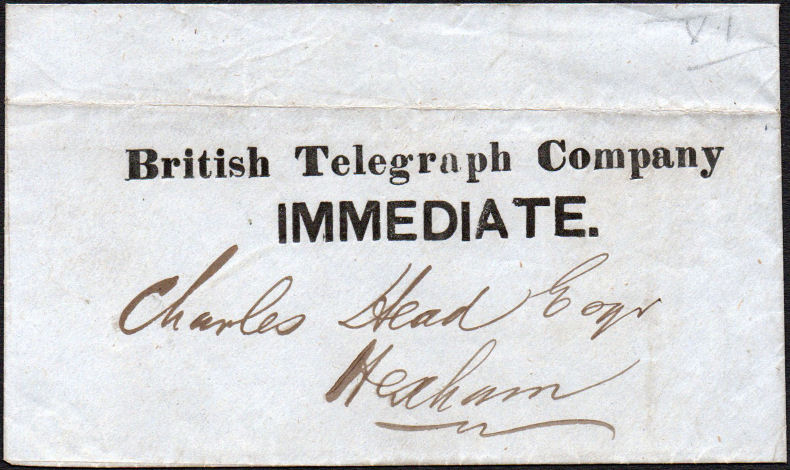
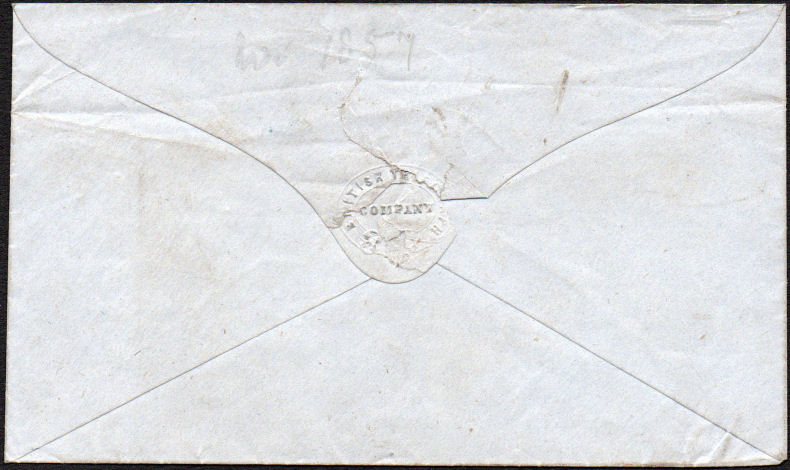
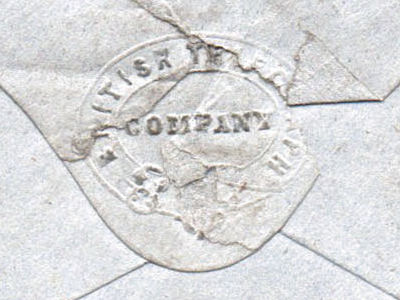
A distinct change to the flap embossing.
| Provisional Reference | Date on form | Date used | size mm. | Logo on flap ? | Comments |
|---|---|---|---|---|---|
| BTC_Env-1856-1 | - | ? | ???? | Coat of Arms | BTC in capitals, 'immediate' in small italic. |
| BTC_Env-1857-1 | - | ? | ???? | B T Co. | BTC normal, 'immediate' in capitals. |
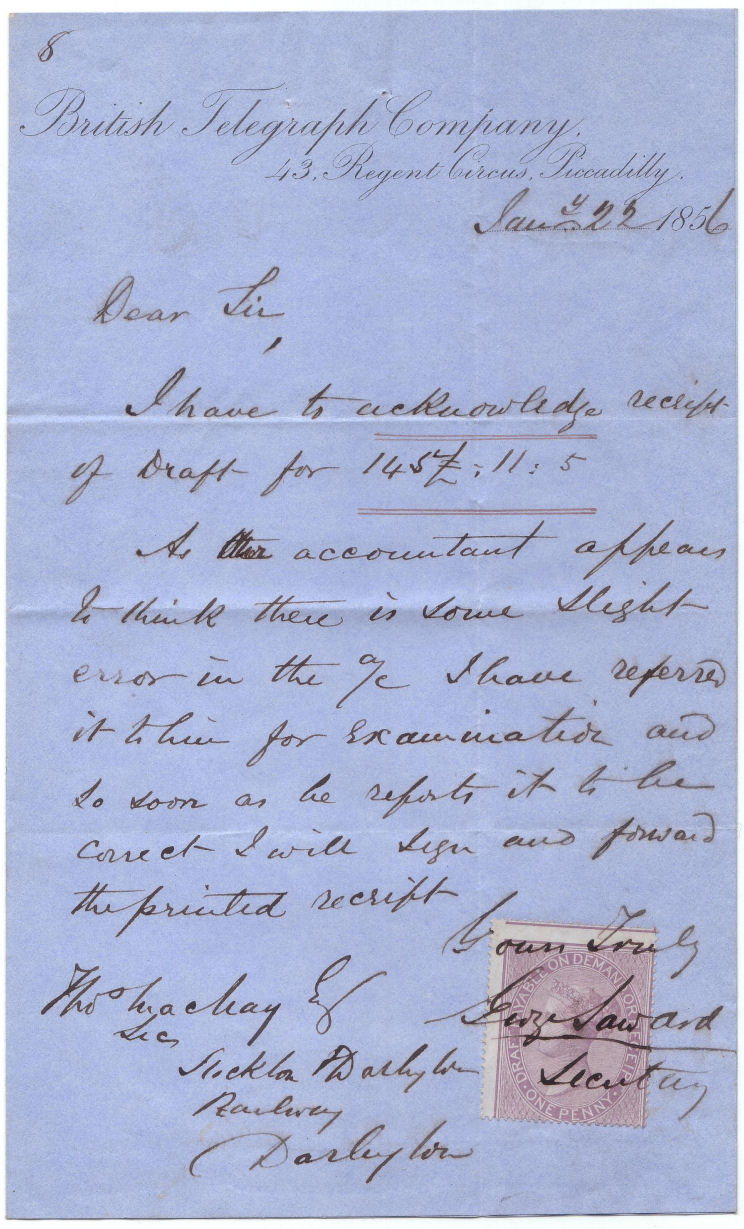
British Telegraph Company receipt of 22nd. January 1856
for £145 11s 5d from the Stockton & Darlington Railway.
Signed George Saward, Secretary - courtesy of Steve Lawrie.
Last updated 7th. June 2021
©Copyright Steve Panting 2012/13/14/15/16/17/18/19/20/21 except where stated.
Permission is hereby granted to copy material for which the copyright is owned by myself, on condition that any data is not altered and this website is given credit.